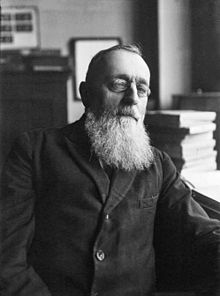Alfred Lacroix
Antoine François Alfred Lacroix (born February 4, 1863 in Mâcon , France , † March 12, 1948 in Paris ) was a French mineralogist and geologist .
Live and act
As the son of a family of doctors and pharmacists, Lacroix, inspired by the writings of René-Just Haüy , Pisani and Ours-Pierre-Armand Petit-Dufrénoy , was already interested in mineralogy in the Lyceum . At the age of 18 he was accepted as a member of the Mineralogical Society of France ( société de minéralogie de France ). After studying pharmacy from 1881 to 1883, he continued his mineralogical studies and entered the Pharmaceutical School of Paris at the same time. He was able to enter the service of Alfred Des Cloizeaux , whereby his laboratories were available to him. He then rose to the position of assistant to the petrology professor Ferdinand Fouqué at the Collège de France , where he got to know microscopic methods and devices of mineralogy. Lacroix was only allowed to complete his dissertation with Fouqué after he had agreed to marry his daughter.
He took courses with Charles Friedel at the Sorbonne , with whom the later pharmacist and volcanologist Albert Brun had studied shortly before , and with François Ernest Mallard (1833-1894) at the École des mines . In the summer of 1884 he made trips to Norway and Sweden , followed by a trip through northern Italy , Sardinia and Elba in 1887 . He carried out further investigations in the Pyrenees . He added to the collection of the National Museum of Natural History at the Collège de France. During this time he also received a diploma in pharmacy.
He obtained his scientific doctorate in 1889 with a thesis on the results of his travels and evaluations of the preparations at the Collège de France and further trips to Canada , Italy and Germany . Through his constant travels, the college and the Natural History Museum have become one of the leading research institutions for mineralogy. One of his most important works is Mineralogie de la France et de ses Colonies (1893–1898) , other important works were created in cooperation with Auguste Michel-Lévy (1844–1911).
Lacroix began to be particularly interested in volcanism and metamorphosis and traveled to Santorini , Madagascar and in 1902 to Martinique to observe the eruption of Mont Pelé . There he met other volcanologists of the time, such as Thomas Jaggar, Jr. and Frank Perret . Lacroix was instrumental in founding the world's second volcano observatory .
In 1904 he became a member of the Académie des Sciences , whose permanent secretary he became in 1914 and remained for 34 years. In 1906 he observed an eruption of Vesuvius and in 1908 of Etna . In 1920 Lacroix was elected to the National Academy of Sciences . He continued his regular travels in Italy in 1924 and in Spain in 1926 . At the Pan-Pacific Congress in Tokyo in 1926 he took part as a representative of France. In 1936 he withdrew from the day-to-day business of research, but continued his investigations in full after the death of his wife in 1944 until his death in 1948.
Lacroix is considered to be the first to describe the minerals Gonnardite (1896), Villiaumite (1908), Soumansite or Sousmansite (1910, identical to Wardite ), Betafit (1912) and Sérandite (1931).
Honors
- Participants of the British Terra Nova Expedition (1910-1913) named the Lacroix Glacier in East Antarctica Victoria Land after him.
- Jean-Baptiste Charcot , leader of the Fourth French Antarctic Expedition (1903–1905), named Mount Lacroix in the Wilhelm Archipelago after him
- Participants of the British Australian and New Zealand Antarctic Research Expedition (1929–1931) named the Lacroix Nunatak in the East Antarctic Adélieland after him.
- A newly discovered mineral described by František Slavík in 1914 was named lacroixite in his honor .
- The Geological Society of London awarded him the Wollaston Medal in 1917 . In 1930 he received the Penrose Medal .
Web links
- Literature by and about Alfred Lacroix in the catalog of the German National Library
- Entry on Lacroix, Francois Antoine Alfred (1863–1948) in the Archives of the Royal Society , London
Individual evidence
| personal data | |
|---|---|
| SURNAME | Lacroix, Alfred |
| ALTERNATIVE NAMES | Lacroix, Antoine François Alfred |
| BRIEF DESCRIPTION | French mineralogist and geologist |
| DATE OF BIRTH | February 4, 1863 |
| PLACE OF BIRTH | Mâcon , France |
| DATE OF DEATH | March 12, 1948 |
| Place of death | Paris |
